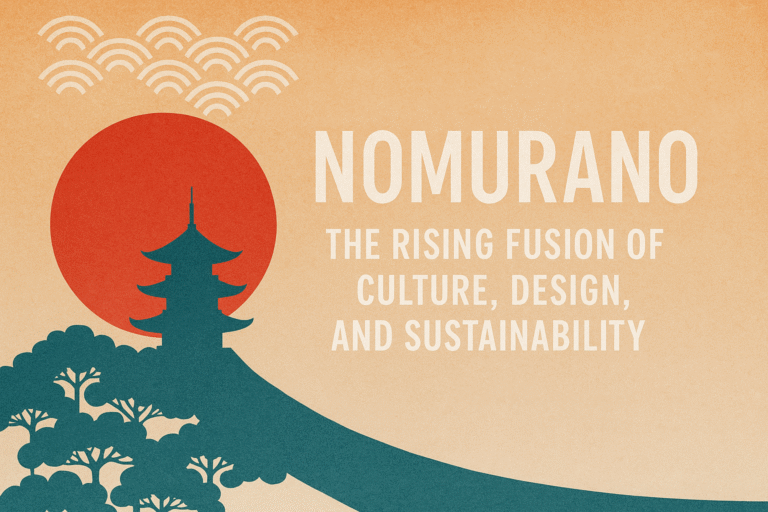In a world increasingly shaped by the intersection of art, innovation, and sustainability, Nomurano has emerged as a concept — and possibly a brand — that embodies the next evolution of lifestyle. While the word “Nomurano” may still be unfamiliar to some, it’s fast becoming a buzzword in the circles of design, fashion, and conscious living.
Whether Nomurano is a name, a movement, or an aesthetic, it carries a mystique that’s attracting attention from creators, thinkers, and innovators across the globe. But what exactly is Nomurano, and why is it capturing the imagination of so many?
Understanding the Essence of Nomurano
Nomurano can be interpreted as a hybrid identity — a fusion of minimalist Japanese aesthetics (suggested by the “Nomo” sound reminiscent of Japanese surnames) with the timeless elegance and glass artistry of Murano, the Venetian island famed for its centuries-old glass-making tradition. This combination signals an artistic philosophy that values precision, subtle beauty, and craftsmanship.
Nomurano is not about extravagance or loud statements. Instead, it’s about intentional living — embracing authenticity, simplicity, and eco-conscious design. It’s a lifestyle ethos where everything, from the materials we use to the items we purchase, aligns with purpose and sustainability.
The Cultural Roots: East Meets West
There’s something poetic about blending elements of Japanese wabi-sabi with Italian artisanal flair. Wabi-sabi celebrates the beauty of imperfection, transience, and natural simplicity. Murano, on the other hand, represents intricate craftsmanship and bold, centuries-old glass traditions. When merged, Nomurano captures the serenity of the East with the expressive soul of the West.
Nomurano-style products often reflect this harmony — handcrafted, minimalist objects made from natural or recycled materials, infused with both function and form. Imagine a lamp made from recycled Murano glass shaped with Zen-influenced lines, or home décor that uses the texture of Japanese rice paper and the color palettes of Venetian sunsets.
This cultural dialogue is what makes Nomurano not just a name, but a bridge between worlds.
Nomurano in Design and Architecture
The world of architecture and interior design has started embracing Nomuran blended sensibility. Architects are drawing on both traditional Japanese minimalism and European craftsmanship to create calming, functional spaces that honor light, nature, and human well-being.
In a Nomurano-inspired space, you might find:
-
Natural materials like bamboo, terrazzo, linen, and hand-blown glass.
-
Neutral color schemes punctuated by earth tones and warm hues.
-
Thoughtful layouts that emphasize balance, asymmetry, and flow.
-
Sustainable features, such as solar panels, reclaimed wood, and energy-efficient systems.
This style reflects a deeper philosophical commitment: to build environments that nourish rather than deplete, that feel intimate rather than imposing.
Nomurano in Fashion and Lifestyle
Nomurano could be seen as a return to slower, more mindful clothing practices. Think capsule wardrobes with pieces that are versatile, timeless, and ethically made. Fabrics like organic cotton, hemp, and peace silk are used to create garments with simple silhouettes, often hand-dyed or woven in small batches.
Accessories also reflect Nomurano values — hand-crafted jewelry, artisan shoes, and bags made from vegetable-tanned leather or recycled materials. In this context, fashion becomes a quiet rebellion against fast consumerism and seasonal obsolescence.
Lifestyle brands adopting a Nomurano ethos typically encourage practices like meditation, nature immersion, conscious eating, and responsible consumption. They appeal to those who seek harmony not just in design, but in everyday life.
Sustainability and Nomurano Ethical Vision
Perhaps the most important pillar of Nomurano is its sustainability ethic. This isn’t just greenwashing or marketing fluff — it’s a deep commitment to circular systems and low-impact production.
Brands and creators working under the Nomurano philosophy often:
-
Use local materials and artisans to minimize carbon footprints.
-
Prioritize durability over disposability.
-
Reduce waste through upcycling and regenerative design.
-
Invest in fair labor and transparency across the supply chain.
The idea is to create items that age beautifully and carry a story, rather than end up in a landfill six months later.
The Future of Nomurano
Nomurano may still be in its infancy as a recognizable movement, but its influence is spreading. As consumers grow more thoughtful and less interested in mass production, there’s an increasing desire for products and experiences that feel personal, intentional, and connected to tradition.
Whether it’s the next big brand or a design philosophy that inspires creatives worldwide, Nomurano symbolizes the blending of worlds — not through domination, but through respect, exchange, and appreciation.
It’s not just a trend; it’s a quiet revolution — one that asks us to reconsider how we live, create, and consume.
Read More: Kennedy Funding Ripoff Report: Separating Fact from Fiction in Private Lending
Final Thoughts
While Nomurano may still be defining itself in the public consciousness, its values are clear: craftsmanship, cultural fusion, sustainability, and a reverence for beauty in simplicity. It may well become a leading concept in the next generation of conscious design and lifestyle movements.
As more people seek authenticity and balance in their lives, Nomurano offers a blueprint — not only for aesthetics but for ethical, intentional living.
